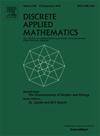The complexity of cluster vertex splitting and company
IF 1
3区 数学
Q3 MATHEMATICS, APPLIED
引用次数: 0
Abstract
Clustering a graph when the clusters can overlap can be seen from three different angles: We may look for cliques that cover the edges of the graph with bounded overlap, we may look to add or delete few edges to uncover the cluster structure, or we may split vertices to separate the clusters from each other. Splitting a vertex means to remove it and to add two new copies of and to make each previous neighbor of adjacent with at least one of the copies. In this work, we study underlying computational problems regarding the three angles to overlapping clusterings, in particular when the overlap is small. We show that the above-mentioned covering problem is NP-complete. We then make structural observations that show that the covering viewpoint and the vertex-splitting viewpoint are equivalent, yielding NP-hardness for the vertex-splitting problem. On the positive side, we show that splitting at most vertices to obtain a cluster graph has a problem kernel with vertices. Finally, we observe that combining our hardness results with structural observations and a so-called critical-clique lemma yields a simple alternative NP-hardness proof for the Cluster Editing With Vertex Splitting problem, where we add or delete edges and split vertices to obtain a cluster graph.
求助全文
约1分钟内获得全文
求助全文
来源期刊

Discrete Applied Mathematics
数学-应用数学
CiteScore
2.30
自引率
9.10%
发文量
422
审稿时长
4.5 months
期刊介绍:
The aim of Discrete Applied Mathematics is to bring together research papers in different areas of algorithmic and applicable discrete mathematics as well as applications of combinatorial mathematics to informatics and various areas of science and technology. Contributions presented to the journal can be research papers, short notes, surveys, and possibly research problems. The "Communications" section will be devoted to the fastest possible publication of recent research results that are checked and recommended for publication by a member of the Editorial Board. The journal will also publish a limited number of book announcements as well as proceedings of conferences. These proceedings will be fully refereed and adhere to the normal standards of the journal.
Potential authors are advised to view the journal and the open calls-for-papers of special issues before submitting their manuscripts. Only high-quality, original work that is within the scope of the journal or the targeted special issue will be considered.
 求助内容:
求助内容: 应助结果提醒方式:
应助结果提醒方式:


